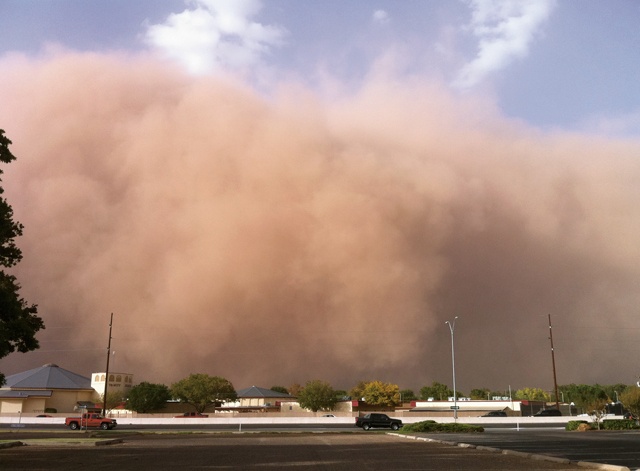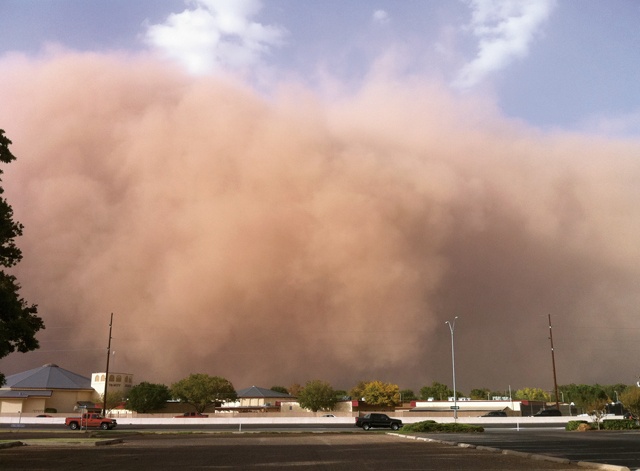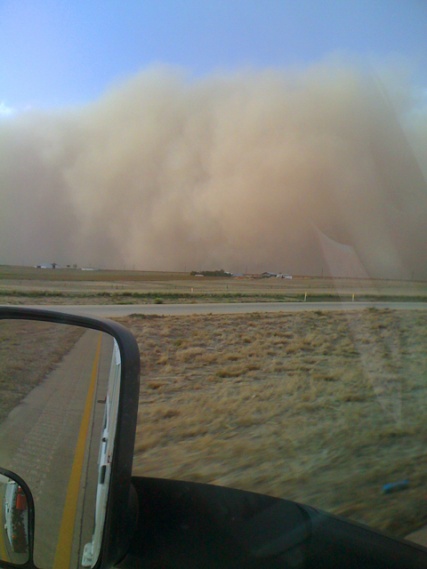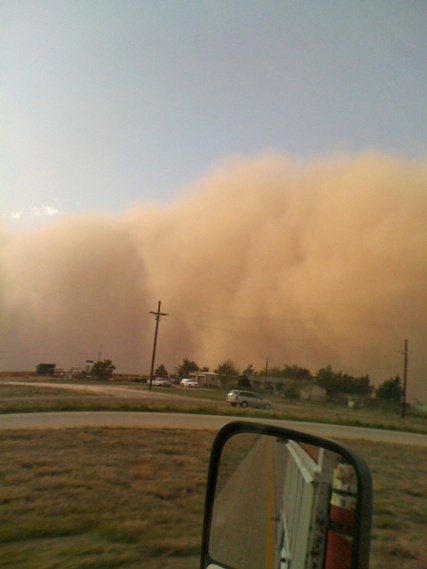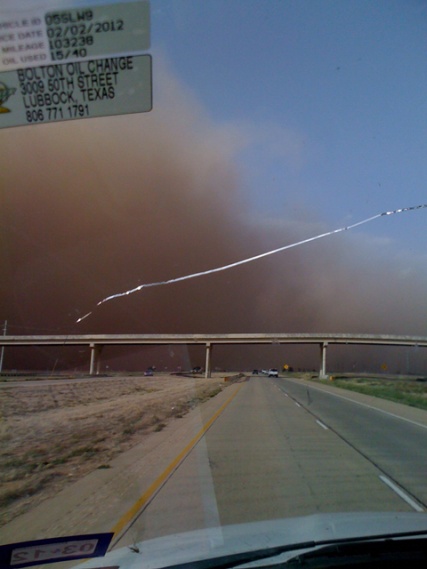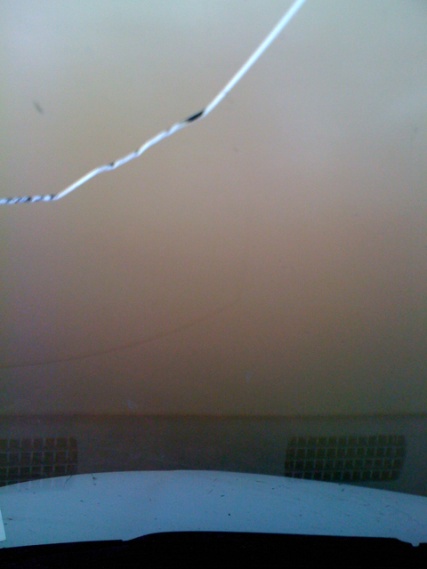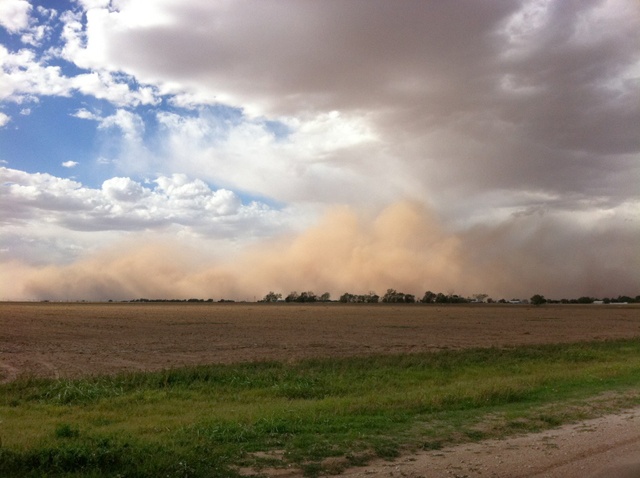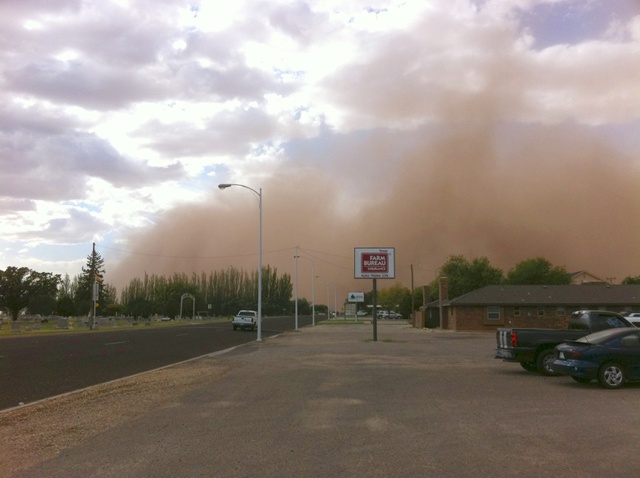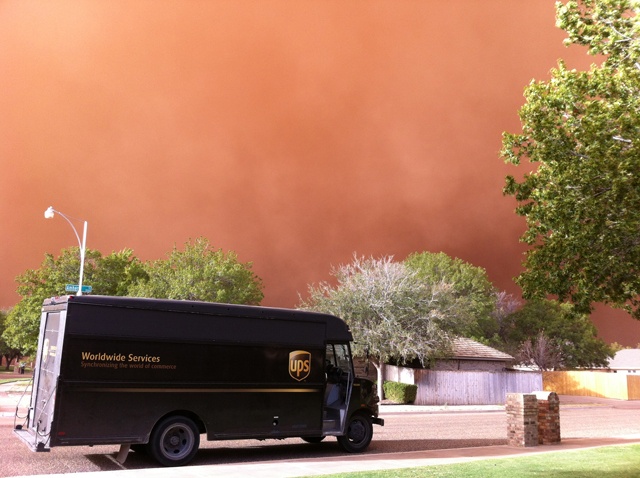South Plains Electric Cooperative Lineman Brent Adcock was on call, driving his bucket truck on Interstate 27 north of Lubbock on October 17, 2011, when he saw an airborne wall of red-brown dirt in the distance moving down the Southern Plains. Stretching far up in the sky and forming a distinctive line at the edge of a northerly cold front, this intense dust storm, or haboob, was coming at him—fast.
“At first, it looked brown, but then it looked like red-colored sand. But it almost looked like … I don’t know,” Adcock paused. “It was just rolling. It looked like a big cloud of dirt rolling across the ground. Pretty intense.”
Adcock and the haboob sped toward each other, and in about five minutes, the wall of dirt he’d spotted 30 miles out was all around him, and the sky went dark. Streetlights came on as though it were night, and sand pelted his truck. The dust was so thick you could taste it.
Unable to see the hood of his truck, Adcock slowed to a crawl for the next five or six miles, trying to navigate through the nearly blackout conditions. “Kind of scary,” he said, admitting he would rather drive through a blizzard.
The dust cleared in under an hour, but Adcock worked all night in the aftermath to help restore power, as straight-line winds downed utility poles and trees and propelled debris into electrical lines.
Before the haboob formed, the autumn Monday had been unseasonably warm, with temperatures ranging from the 80s to 90s across the region. Skies were partly cloudy, and light winds danced over the Caprock.
“It was pretty that whole day,” said Brady Askew, member services adviser for Tahoka-based Lyntegar EC. Askew was at his family’s cotton farm south of Lubbock when the weather suddenly changed. “It was windy all day,” he said, “but nothing like it was when the haboob came.”
By late afternoon, a fast-moving cold front had swept over the Rockies, and sped south into Texas at 50 mph, bringing temperatures down about 20 degrees, according to the National Weather Service.
Over the dry flatlands, winds gusted up to 74 mph—as powerful as a Category 1 hurricane—lifting dirt into the air ahead of the front. Forming about 80 miles north of Lubbock, the thick wall of dust grew up and up, and then quickly raked over the city, where it struck Bradley Allen, South Plains EC system support specialist, as being stranger than science fiction.
He, like most other Panhandle residents, had experienced a “normal Lubbock dust storm” that “comes in low and gets out,” but was not prepared for a full-blown haboob. “It was amazing when I had to turn straight into the cloud. It was daunting, too,” Allen said. “It reminded me of going through the Stargate: You don’t know what’s on the other side.”
But only more dust was on the other side as the system continued to race southward for about three hours, all the way past Askew’s cotton fields, where the winds pulled the white lint from bolls, and then dissipated by the time it reached Taylor EC’s territory near Abilene, where the co-op’s communications director, Kelly Langford Thompson, laughingly said she saw Lubbock blow into town. The amount of dirt carried by those winds was so immense that it showed up on satellite imagery.
“It’s visually impressive because you have all the dust concentrated right at the leading edge of that cold front pushing in,” says Eric Bruning, an assistant professor with Texas Tech University’s atmospheric science department. “That’s what makes it a haboob and not a dust storm—a heavy concentration in a very small area of dust.”
While haboob is an Arabic word for “intense dust storm,” such as those that occur in Africa’s Sahara desert, haboobs are not uncommon in Texas—though they have not always been called by this name.
Similar—although more intense—dust storms were documented during the Dust Bowl era of the 1930s, when extended drought and poor agricultural practices left the land stripped of vegetation. Those extensive storms would start in Nebraska, Kansas or Colorado and roll over huge swaths of the Great Plains.
“But back in the ’30s, they didn’t have that term. It was just called a dust storm,” said Shawn Ellis, a National Weather Service meteorologist who dashed outside his Lubbock-based forecast office to see the haboob change the sky from blue day to red night. “We don’t have those iconic dust storms as much now because of agricultural improvements, and [there are] a lot more grasslands.”
Still, the October 2011 haboob is unique among modern-day Texas haboobs, which tend to occur on the cusps of thunderstorms whose high winds pick up dirt. The recent haboob was unusual because there was no precipitation, Ellis explained: “There were just really excellent conditions to get that kind of haboob.”
The cold front’s strong winds combined with the severe drought to create ideal conditions for a severe dust storm. The Panhandle, like much of the state, experienced high heat and drought in 2011, with Lubbock logging its driest year on record, according to the National Weather Service.
“It’s a historical moment of our time,” Askew said.
——————–
Suzanne Haberman, staff writer
